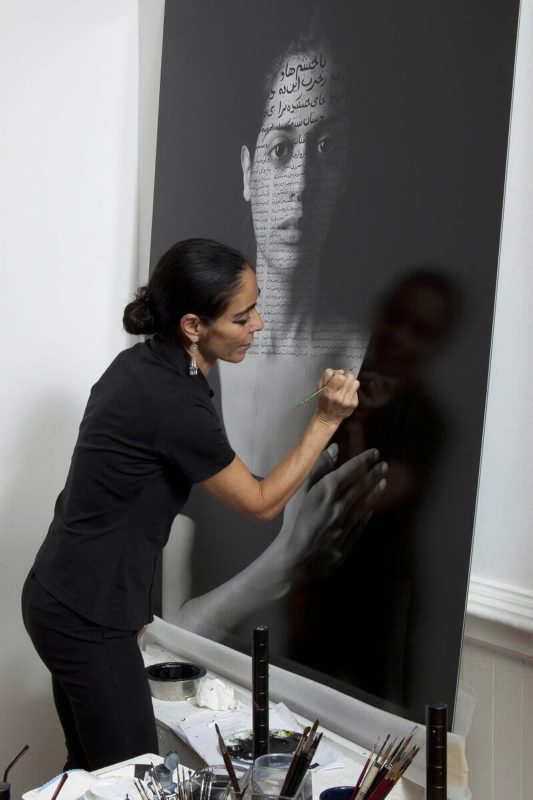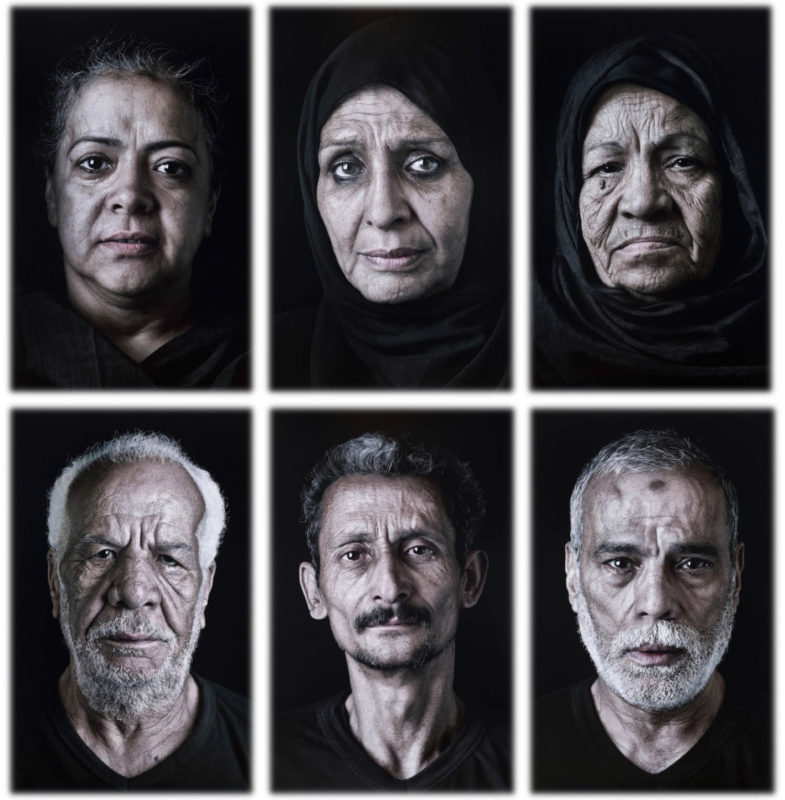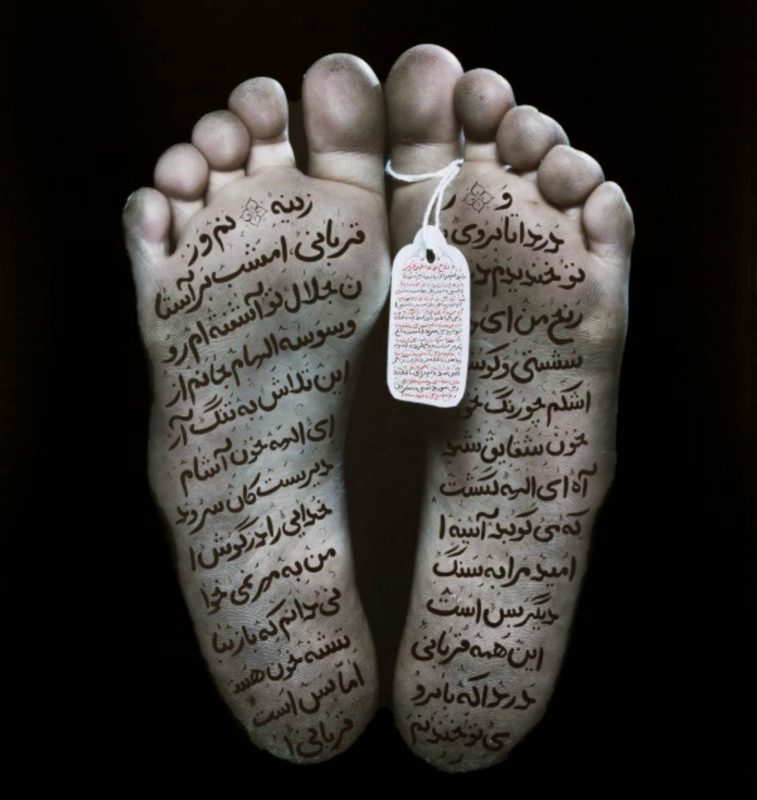
Contemporary visual artist Shirin Neshat continues to cross geographic and cultural boundaries with her artwork. Shaped by self-reflection after experiencing displacement and exile, her pieces challenge the status-quo by exploring controversial themes such as gender and immigration. Neshat has delved for almost three decades into the cultural and political conflicts derived from the collision of Eastern tradition and Western modernity utilizing a variety of artistic media, the power of poetry, and aesthetics of unabated beauty. Here we offer an analysis of some of her most celebrated photographic series.
Shirin Neshat: A Resilient Feminist And A Progressive Storyteller

Shirin Neshat was born on March 26, 1957, in Qazvin, Iran into a modern family that prioritized her access to Western and Iranian cultural history. During the 1970s, Iran’s political climate grew increasingly hostile, resulting in Neshat’s departure in 1975 to the U.S., where she enrolled at UC Berkeley’s Art Program to later permanently reside in New York.
While growing up, Iran was under the leadership of the Shāh, who favored the liberalization of social behavior and economic developments modeled after Western traditions. In 1979, Iran experienced an intense transformation when the Iranian Revolution sprang and deposed the Shāh. The revolutionaries reestablished a conservative religious government, overthrowing initiatives in line with western ideas and the expansion of women’s rights. As a result, a new fundamentalist regime led by Ayatollah Khomeini reasserted control over public and private behavior.
In 1990, after a twelve-year absence, Shirin Neshat returned to Iran. Astonished after witnessing the magnitude of the transformation her country had undergone, she experienced a prolonged state of limbo towards her own cultural identity. Neshat hadn’t yet adopted a westernized identity, yet she no longer identified with her homeland culture. This traumatic memory helped Neshat find her voice, reclaim her identity and embark on a lifetime artistic journey: that of raising questions of political oppression and religious fervor to understand the changes in Iranian national identity and its particular effects on women.
The Women Of Allah Series (1993-1997)

Get the latest articles delivered to your inbox
Sign up to our Free Weekly Newsletter
Considered Shirin Neshat’s first mature body of works, Women of Allah has been considered controversial due to its ambiguity and avoidance of a distinct political stance.
The pieces explore the idea of martyrdom and the ideology of Iranian women during the revolution. Each photograph depicts a female portrait with layers of Farsi calligraphy, juxtaposed with the ever-present image of a gun and the veil.
Neshat challenges western stereotypes about the eastern Muslim woman as weak and subordinate, presenting us instead with the image of active female figures full of resiliency and determination.

Literature and poetry are embedded in Iranian identity as a form of ideological expression and liberation. The visual artist often recurs to texts by Iranian female writers, some of feminist nature. However, Speechless and Rebellious Silence depicts a poem by Tahereh Saffarzadeh, a poetess who writes about the underlying values of martyrdom.
The delicately painted inscriptions contrast with the heavy metal of the guns symbolizing an internal rupture. The woman in the picture is empowered by her convictions and artillery, yet she becomes host to binary concepts such as submission to religion and freedom of thinking.

Allegiance with Wakefulness shows Neshat’s use of calligraphy as a tool to enhance the faces, eyes, hands and feet of women as an allusion to what remains visible of the female body in fundamentalist Islamic regions.
Poetry is Shirin Neshat’s language. It functions as a veil that hides and reveals the significance of the pieces. Each line embodies the failure of cross-cultural communication as the inscriptions remain illegible to most western audiences. We may admire the beauty and fluidity of the manuscript but will ultimately fail to identify it as poetry or understand its significance, resulting in an unavoidable psychological distance between the audience and the photographed subjects.

Way In Way Out can be interpreted as an attempt by the artist to reconcile her ideas regarding the veil as a symbol of freedom and repression. Identified by western culture as a sign of Islam’s oppression of women, the veil has also been reclaimed by many Muslim women who do not identify with American and European women’s liberation movements, rescuing it as an affirmative symbol of their religious and moral identities.

Women of Allah is a powerful example of Shirin Neshat’s paradoxical imagery and her resistance to choose between cliché representations or radical positions towards Muslim women, which are the traditional subjugated or the westernized liberated. Instead, she presents us with the complexity of the contemporary image to emphasize their incommensurability and untranslatability.
The Book Of Kings Series (2012)

Shirin Neshat often says that for her, photography has always been about portraiture. The Book of Kings is a book of faces depicting 56 black-and-white compositions and one video installation inspired by the young activists involved in the Green Movement and the Arab Spring riots. Each photograph depicts an almost psychological portrait that looks back in history to establish visual allegories with modern politics.

Neshat makes the past of mythical Greater Iran meet the present of the country to engage in a profound dialogue. Motivated by these movements that emerged across the Middle East and North Africa in the spring of 2011 as a response to oppressive regimes, the visual artist decided to explore the structures of power in modern society. The title of the series comes from the 11th century Iranian historical poem Shahnameh by Ferdowsi, which Neshat used as inspiration to continue the visual storytelling of the history of Iran.

As a footprint of Neshat’s work, The Book of Kings comes wrapped in history, politics, and poetry. Every portrait acts as a commemoration to honor the unknown identities of young women and men who sacrificed their lives for political freedom during the pro-democracy uprisings in the Arab world.

The photographic series is organized into three key groups: The Villains, The Patriots, and The Masses. The role each group played close to the 2009 political elections in Iran is emphasized by a minimal composition, ancestral drawings, and Farsi inscriptions that veil the subject’s skin.
The text on the photographs reveals contemporary Iranian poetry combined with letters sent by Iranian prisoners. Each frame displays its subject standing individually with a confrontational gaze but placed next to each other to conceptualize their unity during the riots.

Villains are depicted as older men with mythical imagery tattooed on their skins. The tattoos were hand-painted by Shirin Neshat on their bodies with bleeds of red as a symbol of bloodshed. Patriots hold their hands over their hearts. Their faces speak of pride, courage and rage. The words amplify their presence with enlarged calligraphic messages as if demanding to be listened to. The masses’ faces vibrate with intense emotions: convictions and doubts, courage and fear, hope, and resignation.
As geographically and politically specific the series may appear at a first glance, Neshat still appeals to universal themes concerning all humanity such as the defense of human rights and the pursuit of freedom.
Our House Is On Fire (2013)

Cries and devastation are the aftermaths of war. These sentiments echo in Our House is on Fire –interpreted by Neshat as the closing chapter of The Book of Kings. Named after Mehdi Akhava’s poem, these compositions explore the repercussions of social and political conflict at a personal and national level through universal experiences of loss and mourning.

Created during a visit to Egypt, the series speaks of collective grief. Shirin Neshat asked the elders to sit in front of her camera to tell their story. Some of them were the parents of young activists involved in the Arab Spring uprisings.
As mementos of bygone lives, the series range in imagery from solemn aged portraits to identification-tagged feet emerging from morgue scenes. A visual allegory that highlights the ironic fate of a generation of parents mourning over the death of their children.

A most-delicate and undecipherable veil of inscriptions inhabit every fold in the face of the subjects. It is their stories as each told to Neshat. As if the witnessed catastrophes had left a permanent mark on their skin. Changing their facial expressions with the aging that only comes from living in a state of permanent revolution.
Calligraphy here acts as an ambivalent element of solidarity and humanness. Ambiguity has the power to create spaces for reflection. Neshat inscribed onto each individual’s skin in Persian, not Arabic, to portray pain as a universal experience and engage in cross-cultural dialogue amid different countries in conflict.
Land Of Dreams (2019)

In 2019, Shirin Neshat faced a different challenge. She had not returned to L.A. since her graduation due to memories of racism. Now, she was to Greet The Sun Again and welcome her most-anticipated and largest-to-date retrospective exhibition Land of Dreams at the Broad.

Shirin Neshat presented over 60 photographs and 3 videos portraying the face of contemporary America. Departing from stereotypes and exoticizing clichés, she revisited photography after years of films to offer us an unfiltered panoramic view of the American people.

Neshat redefines the American Dream amid one of the most polarized and sociopolitical turmoiled eras in the US by visually narrating a story of representation and diversity. ‘For the longest time I did not feel I was ready to create a work of art that reflects on the American culture. I always felt not American enough or not close enough to the subject.’ Now, Neshat calls upon her own experiences of alienation as an immigrant in the U.S. to reflect on the current social, economic and political climate.

This is the first time the visual artist departs from eastern subjects to focus on the state of affairs in her adoptive country. ‘After the Trump administration, it was the first time I felt my freedom in this country was being jeopardized. I really needed to make a work that expressed immigrants’ perspective in America.’ The result is Land of Dreams, Neshat’s very first series fully shot in the U.S. and a direct critique of the American culture from the standpoint of an Iranian immigrant.

Simin: Shirin Neshat As A Young Visual Artist
Shirin Neshat recreates her younger self through Simin, a young art student with fresh but critical eyes to offer a new perspective that forces us to reconsider what we think we know about the American people. Simin packs up her belongings, picks up her camera, and drives through New Mexico to document the dreams and realities of Americans across the Southwest.

New Mexico, one of the poorest US states, has a rich diversity of white Americans, Hispanic immigrants, African American communities and Native American reservations. Simin knocks door-to-door, introducing herself as a visual artist, asking people to verbally and visually share their stories and dreams. The subjects that Simin photographs are the portraits we see in the exhibition.

Shirin Neshat is Simin, and after 46 years in the U.S., this time she is ready to tell her story, to unveil the reality she lived then as an Iranian immigrant, and to speak of the threats she identifies today as an American.








